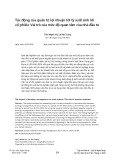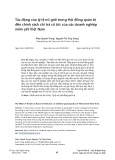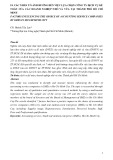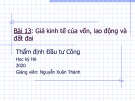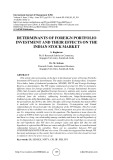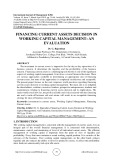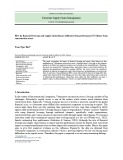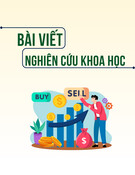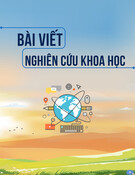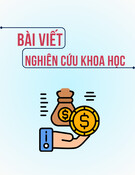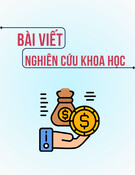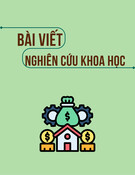
http://www.iaeme.com/IJM/index.asp 24 editor@iaeme.com
International Journal of Management (IJM)
Volume 10, Issue 4, July-August 2019, pp. 24–35, Article ID: IJM_10_04_004
Available online at http://www.iaeme.com/ijm/issues.asp?JType=IJM&VType=10&IType=4
Journal Impact Factor (2019): 9.6780 (Calculated by GISI) www.jifactor.com
ISSN Print: 0976-6502 and ISSN Online: 0976-6510
© IAEME Publication
AN ANALYSIS OF APPLICATION OF KEY
FINANCIAL RATIOS FOR HUMAN RESOURCES
VALUATION IN ORGANIZATIONS
Dr. Govind Patra
Professor in Finance,
Lovely Professional University, Jalandhar, Punjab, India
ABSTRACT
Knowledge workers are now most crucial resources for modern business
organizations which keep all other assets men, money, machine and materials
operative. However, with growing emergence of knowledge economy, the traditional
valuation methods has been put into question due to the non-inclusion of Human capital
as a major part of firm’s total value in balance sheet. The value of Human Resources in
an organization should be measured for sustainable growth of the organization since it
plays the role of motivational tool, efficiency measure yardstick and cost clarification.
Human Resource Accounting (HRA) measures and reports the value of employees in
B/S which helps management take strategic decisions related to human resources in
order to enhance efficiency and productivity. Unlike other category of assets, valuation
of Human Assets seems to be complex. One shortcoming is availability of good valuation
model since all the models developed till now suffer from limitations in one form or
other. This paper tries to suggest a comprehensive, easy to use and relatively limitation
free valuation ratio model termed Intellectual Capital Value (ICV), which is
modification of existing ratio based models available. For this, all the financial ratios
useful for human resources valuation are analyzed first and then the new model termed
Intellectual Capital Valuation (ICV) prescribed.
Key word: ICV, Intellectual Capital, MC, Human Resource Valuation, Human
Resource Accounting, VAIC, CIV, EVA, Tobin’s q.
Cite this Article: Dr. Govind Patra, An Analysis of Application of Key Financial Ratios
for Human Resources Valuation in Organizations, International Journal of
Management, 10 (4), 2019, pp. 24–35.
http://www.iaeme.com/IJM/issues.asp?JType=IJM&VType=10&IType=4
1. INTRODUCTION
Late twentieth and twenty first century witnesses rapid transformation of industrial economy to
a knowledge-based economy as a result of the emergence of new technologies and IT. So, the
importance of human resources as a key element for determination of success of any
organization can not be undermined. HRA is a systematic process of identifying, measuring,
recording and communicating information about human resources value for facilitation of

An Analysis of Application of Key Financial Ratios for Human Resources Valuation in Organizations
http://www.iaeme.com/IJM/index.asp 25 editor@iaeme.com
effective management within an organization. In the knowledge based industries such as IT,
firms recognize people as a key resource to gain competitive edge over their peers. In India,
however there are only few rules and regulations (Section 217 of Company’s act, 1956; SEBI
Guidelines) which mandate firms to disclose very limited information about human resources
in their annual reports. However, many Indian IT firms voluntarily disclose much more
information about their human resource value than is mandatorily required. Human asset
involves continuous significant amount of investment for the organization. But it does not
reflect in balance sheet rather than showing just a mere operating expense in the P&L statement
as per conventional accounting system. Many HR valuation models have been developed for
last half a century but still it is in the nascent stage due to complexities involved and for not
having an easy-to-use, comprehensive and understandable model thereon. We are aware that
there are 4 M’s like Men, Money, Machine and Materials associated with any organization. Of
the 4 M’s, the other three are treated as assets to find a place on the the Balance Sheet. However
the fourth and most important M, i.e Men are still neglected to find a place in financial
statements. The aim of human resource accounting is to depict the potential of human resources
in monetary terms. The benefits of adopting human resource accounting are magnified. It helps
an organization to take managerial decisions based on the availability and the necessity of
human resources. When the human resources are quantified, it gives the investors and other
stakeholders true insight about the affairs of the organization and it’s future potential. It was
only in the mid-1990s, after Infosys started valuing its employees, that the concept gained
popularity in India. Intellectual capital is an intangible value driver in an organization that
brings about future benefits. Modern business environment is quite dynamic and the business
organizations are exposed to numerous changes and challenges on a continual basis. This is
through intellectual capital only, the firms could able to quickly adapt to such changes and
remain competitive in the market. HRA can also be viewed as an important tool for investors
in judging the investment worthiness of the company. Thus, humans resources through HRA
are fast changing to a resource, an asset or a capital from just an expenditure or a cost. Since
the survival, growth and profits of the organizations are perceived to be dependent more on the
intellectual assets than the physical assets in the knowledge era, there arises a serious need to
determine HR investments and value.
Basically, Intellectual Capital (IC) is segmented into three components : Human Capital,
Structural Capital and Relational Capital. The definition, description and meaning of each
component are mentioned below :
Human capital is the major component of intellectual capital which includes professional
competence, social competence, employee motivation and leadership quality. Professional
competence is the experience and the expertise through training, higher education opportunities,
practical experience, courses and seminars. Social competence includes interpersonal skills,
ability to communicate and cooperation amongst employees (Swart, 2006) which in turn leads
to higher level of performance and productivity. Organizations invest in motivating employees
through various methods such as fair compensation, decision making capacity, bonus,
commissions and promotion. Leadership includes the ability to develop and communicate
strategy and vision as well as implement it. Research by Swart (2006) shows that human capital
is critical since it is a strategic source of creativity and innovation in a business. Proper
management of the human capital could help in generating other intellectual assets in a
business.
Structural capital includes product innovation, corporate culture, management instruments,
IT and explicit knowledge, internal cooperation, and process optimization. Product innovation
ensures launching new products which enhances the competitiveness and survival of the firm.
This leads to patents and copyrights among others. Corporate culture relates to values and

Dr. Govind Patra
http://www.iaeme.com/IJM/index.asp 26 editor@iaeme.com
norms that influence knowledge transfer and job interactions. A good corporate culture ensures
that there is compliance to policies and it sets the habit of innovation and improvement.
Management instruments tend to support the effort of leaders and influences the way decisions
are communicated to every employee. Process optimization relates to continuous improvement
of internal procedures and processes. Internal cooperation refers to how workers in the
organization are able to cooperate and exchange information. Structural capital include various
elements such as processes, systems, structures, the intellectual assets, proprietary software,
computer programs, the databases, the organizational culture, trademarks, patents among others
(Choong, 2008). Structural knowledge remains in the organization even when the employees
leave the organization. It tends to make the people work better and in a smarter way.
Relational capital includes relationship with customers, suppliers, public, investors and
other stakeholders of the firm. Aspects such as good customer service enhances strong bonding
with customers. Businesses pursue seriously to improve investor relationship such as providing
accurate information to investors to aid them in decision making. For purposes of achieving a
competitive advantage, long-term and strong relationships to every stakeholder is very crucial.
2. LITERATURE REVIEW
Stewart (1991) argued intellectual capital can be utilized to create competitive advantage. He
defined intellectual material as the aggregate of an organization’s patents, processes,
employees’ skills, technologies, information about customers and suppliers, and old-fashioned
experience. Edvinsson and Sullivan (1996) informed intellectual capital as knowledge can be
converted into value for organizations. Roos and Roos (1997) view intellectual capital as the
most important source for competitive advantage. They argued that a systematic approach to
measure intellectual capital is increasingly essential now for companies regardless of the
industry, size, age, ownership, and geographical dimensions.
Generally, researchers have divided the concept of intellectual capital into three main
constructs (Bontis, Chua, & Richardson, 2000). Bontis (1996; 1998; 1999), Roos et al. (1998),
Stewart (1991; 1997), Sveiby (1997), Edvinsson and Malone (1997) defined intellectual capital
as composition of human, structural, and relational capital.
Elaborating on the difference between intellectual capital and knowledge, Roos et al. (1998)
argued While knowledge is a part of IC, IC is much more than knowledge. Brands, trademarks
and relationship management with external parties (trade distributors, peers, customers, local
communities, stakeholders in general and the like) are all dimensions of value creation (p. 24).
Bontis (1999) also observed human capital is important since it is the source of innovation for
organizations.
Structural capital is the knowledge that stays in the firm when employees go home for the
night (Ordonez de Pablos, 2004; Roos et al., 1998). Therefore, organizations usually have
residual claim on it. Employees provide structural capital for the company and the company is
the residual owner of it. Structural capital comprises all kinds of “knowledge deposits” such as
organizational routines, strategies, process handbooks and databases (Boisot, 2002; Ordonez de
Pablos, 2004; Walsh & Ungson, 1991).
Relational capital comprises the knowledge embedded in all the relationships an
organization develops, whether it is with customers, competitors, suppliers, trade associations
or government bodies (Bontis, 1999). One of the main categories of relational capital is
customer capital that signals market orientation of organizations.
According to Marr et al. (2004), organizations need to recognize and manage their
knowledge assets in order to excel and improve business performance. Chen et al., 2005; Firer
& Williams, 2003; Riahi-Belkaoui, 2003; have argued that if the market is efficient, investors
will put higher value on firms with greater intellectual capital. Furthermore, Chen et al., (2005)

An Analysis of Application of Key Financial Ratios for Human Resources Valuation in Organizations
http://www.iaeme.com/IJM/index.asp 27 editor@iaeme.com
maintained that if intellectual capital is a valuable resource for a firm’s competitive advantage,
it will contribute to market valuation and financial performance.
Using Taiwanese listed companies and applying VAIC intellectual coefficients, Chen et al.
(2005) observed human capital and structural capital have a positive impact on a firm’s financial
performance and market value. In addition to using VAIC coefficients as proxies for intellectual
capital components, they also utilized R & D expenditures as a proxy variable for structural
capital and found a significant relationship between R & D expenditures and profitability.
Investigating Austrian industries, Bornemann (1999) found there exists a positive
correlation between human capital and financial performance in an organization. According to
Fajana (2002), a well–developed system of human resource accounting could contribute
significantly to internal decisions by management and external decisions by investors. Rao
(2005) opined that human capital accounting helps potential investors judge a company better
on the strength of human assets. Thus, if two companies offer the same rate of return on capital
employed, information on human resources can help investors decide which company to choose
for investment.
3. OBJECTIVES
Human Resources valuation is still under development. Many researchers have undertaken to
fulfill various objectives relating to human resource accounting in financial statements. The
objectives we delineate here are:
i) To assess certain financial ratios useful for human resources valuation;
ii) To depict the limitations of such ratios in valuing human assets;
iii) To develop a ratio based comprehensive, easy to use model for human asset valuation
named Intellectual Capital Value (ICV);
4. HUMAN RESOURCES VALUATION MODELS UTILIZING
FINANCIAL RATIOS
Return on Assets (RoA) and Market Capitalization (MC) Methods are calculation of certain
financial ratios used to measure intellectual capital value at organizational level.
4.1. Market Capitalization Methods
Sveiby (2007) mentioned the ratios under Market Capitalization methods offer some ways to
calculate the value of intellectual capital or intangible assets through the difference between the
firm’s market capitalization and its stockholder’s equity. A common characteristic of MC
methods is that they all use capital market values to estimate the aggregate value of IC.
Prominent methods falling under this category are Tobin’s q, Market-to-Book Value ratio and
Stock Market Capitalization to GDP Ratio which is in other words known as Buffet Indicator.
4.1.1. Market Capitalization
Many famous authors in the field of human resource valuation (Brooking, 1996; Edvinsson,
2000; Edvinsson & Malone, 1997; Stewart, 1997) argued that the difference between market
value of the company’s shares & debt and book value of assets reported in the balance sheet
can be associated with the value of intellectual capital. Market capitalization of a firm is simply
measured by multiplying no. of outstanding shares with current market price of the stock. Total
wealth of the firm is sum of tangible physical assets, intangible financial assets, and value of
intellectual capital which is sum total of human capital, structural capital and relational capital.
Since, physical and financial assets are already shown in asset side of balance sheet, so
subtracting total assets from market capitalization of firm, will give the total value of
intellectual capital for the firm.

Dr. Govind Patra
http://www.iaeme.com/IJM/index.asp 28 editor@iaeme.com
The limitations of this method is that since market capitalization changes very frequently
with change in market price of share, but the asset value doesn’t change so much and so often,
means that value of intellectual capital (IC) continually changes.
4.1.2. Tobin's Q
While Tobin is often credited as creator of q ratio, but it was first designed and reported by
economist Nicholas Kaldor in an academic publication in 1966.. The Tobin's Q ratio measures
market value of a company divided by its asset replacement cost. Thus, equilibrium is reached
when market value equals replacement cost or Tobin’s Q equals 1.
Tobin’s Q = Total Market Value of Firm / Replacement Cost of Assets
Replacement cost refers to the cost of replacing an existing asset based on its current market
price. It may be less or more than the acquisition or purchase price. Since the replacement cost
is difficult to estimate, so it may be approximated to book value of equity and debt.
Tobin’s Q=Market Value of Equity and Debt / Book Value of Equity and Debt
Assuming market value and the book value of a company's liabilities/debt are same since
market value of debt hardly changes, the formulae can further be simplified to :
Tobin’s Q= Market Value of Equity / Book Value of equity
Q values of less than one means cost to replace a firm's assets is greater than the stock
market value and hence the stock is undervalued. Conversely, a high Q value of more than 1
implies that a firm's stock is more expensive than the replacement cost of its assets and hence
overvalued.
Stewart (1997) argued that even though Tobin’s q was not originally developed to be a
measure of intellectual capital but it actually signals a good indicator of intellectual capital
value. High ‘q’ ratios signal the firm might be earning extraordinary returns on the basis of its
intellectual capital and may not be always overvalued. Two firms may have similar fixed assets,
but one who has superior people, process, systems and customers will be able to earn more
returns.” (Stewart, 1997, p. 226).
Bontis (1998) supported this argument by stating that Tobin’s q value is different across
different industries. Firms in the software industry enjoy an average Tobin’s q ratio of close to
seven due to their high degree of intellectual capital value. However, firms in traditional steel
and power industry might have an average ratio of close to one due to their reliance on physical
capital and labour.
The limitation of Tobin’s q is to derive value for replacement cost of assets. Market values
of stocks and bonds can be determined from capital market data which is readily available.
However, unless there is a ready made market for used assets of that industry, it is difficult to
find out replacement cost.
4.1.3. Market Value to Book Value Ratio
Chen & Hwang (2005) argued that the market-to-book value ratio, as a reasonable measure to
value IC, has received widespread attention from researchers in the field of IC. Supporting the
ratio, Stewart (1997) argued that market- to-book value ratio is easy to understand and
calculated easily. This ratio becomes very useful for comparison of performance of firms in the
same industry. Furthermore, managers and other interested stakeholders would carry a better
image if firm’s market-to-book ratio is more than its peers in the same industry or rises over
time (Stewart, 1997).
However, the limitations of this method as discussed earlier is that the market is volatile
and share prices are subjected to frequent change in prices and quite sensitive to other economic
and general conditions that are external to the organization. Secondly, depending upon
depreciation rate and method used, the book value of the assets reported in the balance sheet


